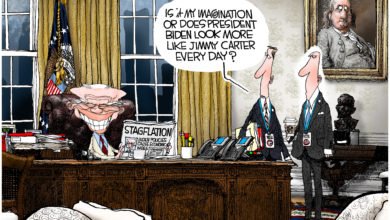
- Several advocates of electric vehicles (EVs) have gone on road trips and ended up facing unexpected problems.
- Secretary of Energy Jennifer Granholm, CEO Jim Farley, and New York Times reporter David Gelles have all taken EV road trips that have unexpectedly demonstrated some of the shortcomings of the vehicles, which the Biden administration is pushing aggressively to help reach its wider climate goals.
- “The nation’s EV infrastructure is not ready for prime time,” New York Times reporter David Gelles wrote in a recently-authored piece for the Times. “I recently found this out the hard way.”
Proponents of electric vehicles (EV) keep going on long drives believing the vehicles will perform as reliably as gas-powered cars, but end up encountering problems while on the road.
Energy Secretary Jennifer Granholm, Ford CEO Jim Farley and New York Times reporter David Gelles all embarked upon EV road trips using the vehicles that the Biden administration is seeking to impose on American consumers in the coming decade. However, each of these trips ran into significant reliability and performance challenges that suggest the EV transition may not be as smooth as advocates anticipate it will be.
Common gripes that American consumers have with EVs include inadequate charging infrastructure, higher costs, worse performance in cold weather, battery degradation and inconsistent range, according to Top Speed. EVs can cost as much as $10,000 more than internal combustion engine vehicles, according to CBS News.
Granholm embarked on her four-day July trip through the Southeast to promote EVs and the jobs their production will create, a key selling point of the wider “Bidenomics” agenda, according to NPR. However, her journey faced several challenges related to EV charging: the vehicle she drove for the trip had a hardware issue that complicated charging, and one of her staffers raced ahead of her to reserve a spot at a charging station using a gas-powered vehicle.
The staffer would not get out of the spot when requested by a family, which had a crying infant in tow, looking to use the charging station before Granholm showed up, according to NPR. Eventually, the police were called to sort out the situation.
Gelles rented an EV from Hertz over the summer to make the 154-mile drive from Minneapolis, Minnesota, to a farm near the state’s border with South Dakota to gather information for a story about agriculture. He documented his experiences on the open road in a Thursday piece for the Times, observing that his trip was, in theory, emblematic of “the kind of long drive through sparsely populated farmland that is a hallmark of American car culture.” “The nation’s EV infrastructure is not ready for prime time,” Gelles wrote. “I recently found this out the hard way.”
Gelles described having to charge his vehicle while en route, gaining just 2% of the battery life back after 30 minutes of charging. Upon reaching his destination, he plugged in his EV to charge overnight with the cable kept in the vehicle to ensure that he would have sufficient power to make it back to Minneapolis the next day.
The next morning, the EV he had rented did not have enough power to make it back to Minneapolis, so he had to call the rental company to arrange for a tow truck to provide a ride for himself and for his otherwise-stranded EV. He made it back in time to catch his flight out, but the rental company billed him more than $700 for the services rendered.
Farley, whose company is set to lose $4.5 billion on its EV production this year, remains confident in their longer-term profitability. He embarked on a Route 66 road trip in August in Ford’s F-150 Lightning electric pickup truck, noting that “there are things you can’t learn in an office or from a PowerPoint,” in a LinkedIn post announcing the trip.
While on the road, Farley encountered inconsistencies in available charging. Some of the EV chargers he used were effective and provided a painless experience, while in another case, he had to use a low-speed charger that juiced up his truck’s battery to 40% in 40 minutes because there were no high-speed chargers available, he said on X, formerly Twitter. “It was a really good reality check,” Farley said of his experiences with EV charging, which he also described as “pretty challenging.”
The Biden administration, recognizing the up-front costs for both EV producers and consumers, has spent billions of dollars and aggressively regulated markets to facilitate its EV push. President Joe Biden is aiming for 50% of all new vehicle sales to be EVs by 2030, according to the White House.
The administration has committed $12 billion to allow manufacturers to retrofit their plants for EV production and $7.5 billion from the bipartisan infrastructure law to develop a national charging network, while the Inflation Reduction Act (IRA) contains $12.5 billion worth of tax credits to entice consumers into switching to an EV, according to UtilityDive.
Content created by The Daily Caller News Foundation is available without charge to any eligible news publisher that can provide a large audience. For licensing opportunities of our original content, please contact licensing@dailycallernewsfoundation.org




